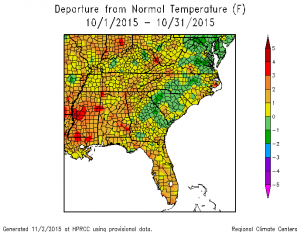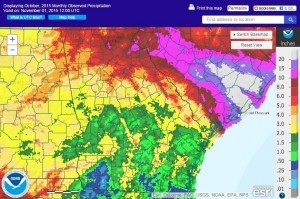Precipitation varied widely across the state of Georgia in October 2015. The impact of the South Carolina flood event was seen in the northeast, but other parts of the state were well below normal in precipitation. Temperatures across the state were near normal. Severe weather was officially reported only on the first day of the month.
Temperatures across the state were close to average compared to the western half of the country, which was well above normal. In Atlanta, the monthly average temperature was 64.1 degrees F (0.8 degrees above normal), in Athens 62.2 degrees (0.8 degrees below normal), Columbus 66.5 (0.0 degrees below normal), Macon 64.3 (0.6 below normal), Savannah 68.2 (0.3 above normal), Brunswick 70.2 (0.0 below normal), Alma 68.3 (0.1 below normal), Augusta 64.0 (0.4 below normal), Albany 69.0 (0.9 above normal), Rome 61.8 (0.6 above normal), and Valdosta 70.2 (1.5 degrees above normal). In general, the warmest temperatures were in areas where the precipitation was lowest.
One daily temperature record was broken in October. Alma reported a low of 39 F on October 19, breaking the old record of 40 F set in 2009. Macon also tied a record high of 88 F on October 16, matching the observation from 1971.
The highest monthly total precipitation from National Weather Service reporting stations was 6.43 inches in Rome (2.57 inches above normal) and the lowest was in Albany at 0.65 inches (1.94 inches below normal). Atlanta received 2.55 inches (0.86 below normal), Athens received 5.00 inches (1.45 inches above normal), Columbus 1.07 inches (1.51 below normal), Macon 1.70 inches (1.09 below normal), Savannah 1.78 inches (1.91 below normal), Augusta 4.62 inches (1.35 above normal), Alma 3.26 inches (0.23 above normal), and Valdosta 1.73 inches (1.47 inches below normal).
The tight gradient in rainfall from Charleston (which received 18.91 inches) to Savannah (which received just a tenth of that) was remarkable and shows how localized the rain from the South Carolina flood event was. The doubled impacts of Hurricane Joaquin and the upper level low to the west concentrated the rain into a small region that missed most of Georgia. The heaviest rain in Georgia from this event occurred in the northeast mountains. Local stream flooding occurred in some locations but was much less than the extensive flooding that occurred in South Carolina.
Two daily rainfall records were set in October. Alma received 2.51 inches on October 1, breaking the old record of 0.58 inches set in 1989. Brunswick received 3.38 inches on the same date, surpassing the old record of 0.76 inches set in 1957.
The highest single-day rainfall amounts from CoCoRaHS stations were all set on October 4 in conjunction with the South Carolina flood event. The highest in the state was 5.20 inches observed northeast of Hartwell in Hart County on October 4, followed by 5.14 inches received west of Dahlonega in Lumpkin County and 4.91 inches received near Sylvania in Screven County. The highest monthly total rainfall was 14.07 inches, observed northeast of Dillard in Lumpkin County. The Sylvania observer received 10.31 inches for the month, followed by 10.08 inches observed near Baldwin in Banks County.
Only two isolated wind damage reports were made in October, both on the first day of the month, although there were some unofficial reports of wind damage in Athens on October 7 due to windy conditions that caused trees in wet soil to fall and damage several houses and cause isolated power outages.
Wet conditions early in the month caused boll rot in some cotton plants and caused problems with hay rotting in the fields. They also caused a slight reduction in drought conditions across the state. However, the rest of the month was quite dry. Many farmers welcomed the dry conditions so they could harvest cotton and peanuts and cure hay for the winter. At the end of the month farmers were waiting for rain to return so they could start planting winter cover crops and small grains.
The outlook for November shows an increased chance of warmer and wetter than usual conditions across the state, which should aid in the removal of drought throughout the state.
For more information please see the “Climate and Agriculture” blog at https://site.extension.uga.edu/climate/ or visit our new web page at https://www.gaclimate.org. Please feel free to email your weather and climate impacts on agriculture to share on the blog to pknox@uga.edu.


